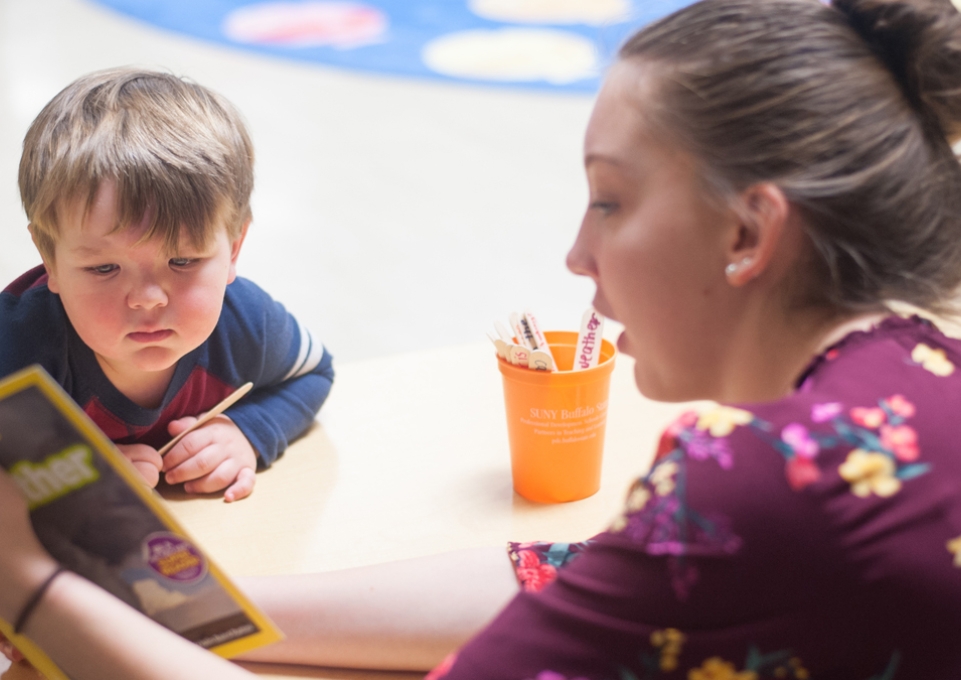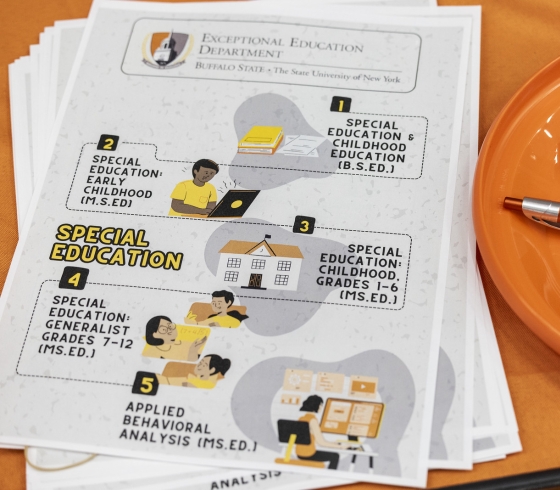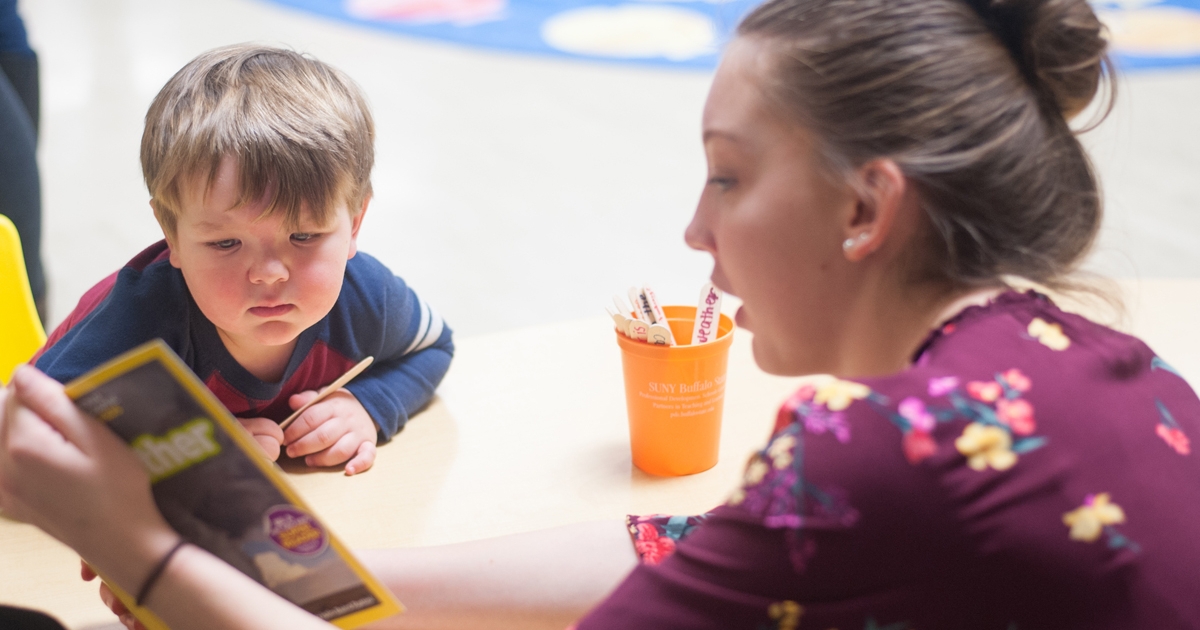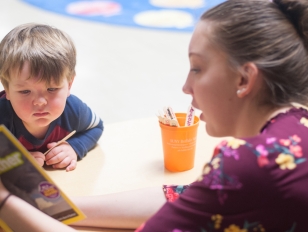
No two students have the same needs. At Buffalo State University, teachers-in-training not only learn this in class but also experience it in practice through the School of Education’s highly individualized approach to teacher certification.
Since it opened its doors as a New York state teachers college in 1871, Buffalo State has been the gold standard in teacher education. Today, the university offers more than 55 pathways to become a teacher, allowing students to choose a program that most specifically meets their interests and future employment goals. And it works: within the first year after graduation, 89 percent of Buffalo State teacher education alumni are working in the education field.
“Buffalo State provides the most individualized approach to certification,” said Wendy Paterson, dean of the School of Education. “We have programs that meet the needs of the ‘typical’ undergrad coming to us right after high school, but also for returning students and people who want additional certification. We match the program to the person.”
For example, rather than offering just one degree in early childhood education, those looking to certify in early childhood education can choose from four readily available paths: early childhood education, birth through grade 2, B.S.; early childhood education, birth through grade 6, B.S.; special education, early childhood program, M.S.Ed.; and childhood and early childhood curriculum and instruction, M.S.Ed.
Leslie Lawrence, who recently obtained her master’s degree in childhood and early childhood curriculum and instruction with a concentration in educational leadership, was already working in the field as a teacher at Community Action Organization of WNY when she decided to further her education at Buffalo State.
“I knew this particular program would expand my horizons to be able to teach in a public school, especially kindergarten,” Lawrence said. “I love watching children learn something that I helped teach them and that look of excitement on their faces.”

Lawrence has already seen the impact of her studies in her current position. “I’m able to take what I have learned from my professors and implement it into my classroom,” she said. “I have a new way of thinking about curriculum. I learned how to teach it, why we do it, and make it fun and interactive to all kinds of children. If we are to teach, we have to ourselves know what and why we are teaching.”
Buffalo State also developed the science education, M.S.Ed., designed for individuals holding an undergraduate degree in a core science—biology, chemistry, earth sciences, geology, or physics—who want to teach. Buffalo State also offers a master’s degree in technology education. Paterson said this allows students to laser focus on their subject areas during undergraduate study and then apply that knowledge to teaching practices during graduate study.
Graduate student Janinna Farragher had a unique vision for her teaching career. After completing undergraduate study in Buffalo State’s art education program—one of the few in New York State—she wanted to find a way to expand her practically applicable skills and help her future students do the same. Farragher chose to pursue a master’s in technology education.
“Being an artist is more than just being a freelancer or famous painter,” Farragher said. “Artists are thinkers and makers, just like engineers and technicians. With technology integration, my students can build their skills in designing solutions, developing questions, and using creative elements with science and engineering practices. This program has allowed me to dive into my mission of art and technology fusion by allowing me to observe master teachers, participate in international teaching programs, and conduct research investigations.”
Farragher credits Buffalo State’s approach to student-specific education with her ability to follow through on her vision.
“Buffalo State allowed me to develop my own path of success by allowing me to choose classes and content-specific courses that align with my interests,” she said. “Buffalo State has many different pathways that can help you get to where you want to be in however many years you need. During COVID, friends at other colleges said that their schools’ programs struggled to transition and accommodate teacher candidates and their needs. I was so thankful to have a close community in the School of Education that supported us and sought to make sure no one fell behind.”
Recently, Buffalo State announced the deactivation of 37 programs, including early childhood education, B.S.; literacy specialist, 5–12, M.P.S.; and many science education certificates; however, it is important to note that these were not active programs. They were certification tracks long discontinued in favor of more specialized offerings. For example, literacy specialist, 5–12, M.P.S. has been replaced with literacy specialist, birth through grade 12, M.S.Ed.—as required by New York State—and the deactivated science certificates have been folded into the preexisting science education master’s program.
“We’re not deactivating active programs,” Paterson said. “We’re moving in the direction the public, the state, our community, and demographics require.”
“We’re not deactivating active programs. We’re moving in the direction the public, the state, our community, and demographics require.”
Buffalo State’s School of Education not only responds to the needs of its students but also the needs of its community. In response to the statewide teacher shortage, in 2022, Buffalo State launched its Find Your Path Back to Teaching initiative, which provides individualized assessments, advising, paths, and support systems for individuals who started a teacher education program but did not complete all certification or program requirements.
In addition, Buffalo State provides students with plentiful additional educational and personal development opportunities such as the Urban Teacher Academy, the New York State Master Teachers Program, the Michael and Nancy Chicola International Professional Development Schools (PDS) Consortium, and International Graduate Programs for Educators. These programs further enhance future teachers’ abilities to connect with and serve all kinds of students by developing communication and cultural awareness.
“I was a determined teen who wanted nothing more than to become a successful first-generation college student,” Farragher said. “I chose Buffalo State because of its recognition for various well-equipped teacher preparation programs and because I wanted to be seen as a person, not a number. I needed a school as unique as I am.”
Photos by Buffalo State photographer Jesse Steffan-Colucci and Buffalo State Marketing and Communications.



